Gangwon is without doubt the best winter destination in Korea.The province offers a wide variety of winter sports activities for visitors to enjoy,such as skiing and trekking in the beautiful snow. It is also home to exciting winter festivals,the best-known being the annual mountain trout festival in Hwacheon.
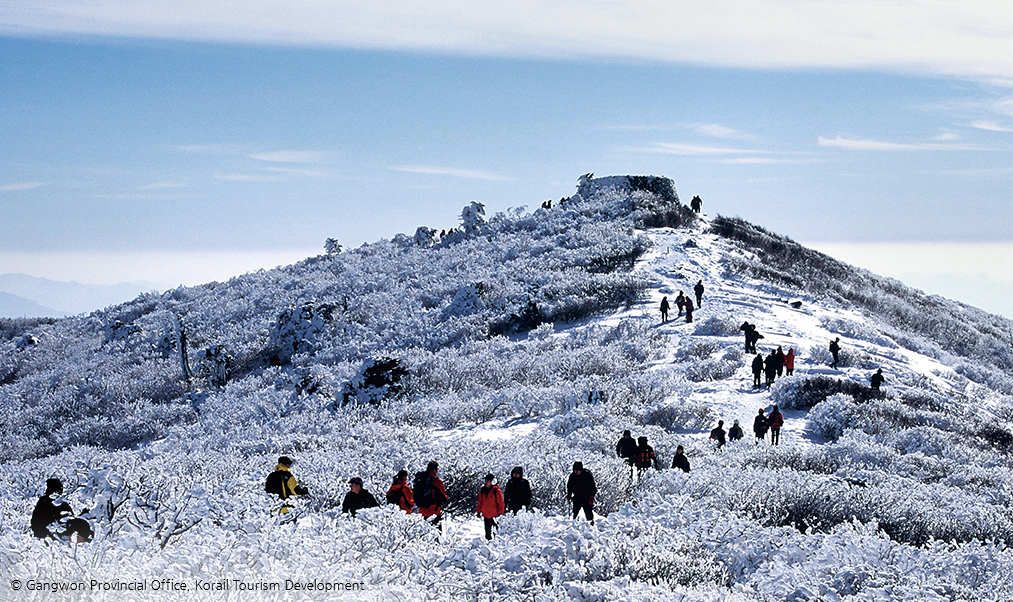
Janggundan (Altar for the General God) is one of the three altars built to worship heaven on top of Mt. Taebaek in ancient times. On the first day of the New Year, many people climb up here to watch the rising sun and pray for good fortune in the year ahead. The hike up to the peak is not easy, but the beautiful snow-covered trees make it a popular hiking trail, especially in winter.
T he best time to visit Gangwon Province is the cold winter — although other seasons also have their own merits — and the best way to truly experience the winter there is by hiking through the magical snowy landscape. On an exceptionally snowy day last winter, I headed to Mt. Taebaek without a moment’s hesitation to experience the wintery charm of Gangwon.
In spring, Mt. Taebaek is covered with vibrant pink azaleas, while in summer and autumn, wildflowersa heavenly garden. But the mountain is most stunning in winter when the snowflakes on the branches of trees glisten in the sun. The spectacular sight of the snow-covered branches swaying in the wind like silvery sweetfish is worth braving the piercing cold.
The distance to the top is four kilometers. In summer, it takes two hours at most, but in winter, with your feet sinking in ankle-deep snow, it can take a good four hours. Climbing the most challenging section called Kkalttak Hill will literally take your breath away. But once you pass Cheonjedan, an altar to heaven at the summit, the tough part is over.
When the cold winds have almost dried the sweat running down your face and body, the ridges of the Baekdu Daegan mountain range come into view through the forest. Close to the summit is a yew habitat. Standing undaunted, enduring the harsh winter winds, the bare trees harbor the energy of life that is waiting to sprout. Maybe that’s why people used to say the yew trees here “live a thousand years in this world and another thousand in the next.”
Woljeong Temple in Pyeongchang County on a snowy day is just as spectacular as the snow-covered Mt. Taebaek. Take a walk on the snow-covered road lined with fir trees, making fresh footprints, and find yourself enveloped in complete and utter silence. Silence is hardly the best description; it is as if the snow has sucked in all the sound around it. There is a tranquil beauty in the sight of a Buddhist monk in a gray robe, hurrying over a fresh blanket of snow in the early hours of the morning.
Winter Festivals to Blow Your Stress Away
If mountain hiking is not up your alley, try one of the many winter festivals the region has to offer. The Mount Taebaek Snow Festival, held every January, features magnificent snow sculptures with themes reflecting current trends. Visitors can see the work of Korea’s finest snow sculptors, d with superb workmanship. In the upcoming festival, works celebrating the 2018 PyeongChang Winter Olympics will be on display.
Aside from feasting your eyes, there are plenty of fun ice and snow activities to enjoy: sledding on a big plastic bag; an ice slide that is popular with children; and an igloo café where couples and families can chat and warm up over a hot beverage. Family visitors can also enjoy dog sledding and snowmobiling in the pine grove in front of Taebaek Minbak [Homestay] Village. Dashing through the snowy fields on a sled pulled by Siberian Huskies is an exhilarating experience that will blow your stress away.
For fishing enthusiasts, Hwacheon is the place to relish the true charm of winter fishing. The rivers here are covered in a thickof ice, providing a great venue for various ice activities. The Hwacheon Sancheoneo Ice Festival, in particular, has transformed the region into a popular winter destination. Held annually from January to February at Hwacheon Stream, it is not only the most famous winter festival in Korea, but has also been ranked among the world’s four major winter festivals, along with the Harbin Ice and Snow Festival in China, the Sapporo Snow Festival in Japan and the Quebec Winter Carnival in Canada. It has attracted over one million visitors a year for 11 consecutive years and has been mentioned in Korean textbooks. In 2011, the U.S. cable news channel CNN introduced the festival as one of the “7 wonders of winter.”
The main attraction of the festival is the ice fishing and barehanded fishing of sancheoneo, or mountain trout. The fish caught can be cooked on the spot at a restaurant nearby. Mountain trout, rich in nutrients, has long been a favorite. In China, Taoist immortals are said to have enjoyed the fish, while in Japan, it was given as a present to the imperial family. At night, the Seondeung Festival lights up the town, seondeung meaning “a light guiding you to the world of immortals.” Beautiful trout-shaped lanterns illuminate the night sky around Hwacheon Stream and the marketplace.
Although smaller in scale than the mountain trout festival, the annual Pyeongchang Trout Festival is also very popular. It takes place on the banks of Odae Stream from late January until late February. In addition to popular programs such as ice fishing, barehanded fishing and family fishing, there are a host of winter activities to enjoy, including ice sledding, snow rafting, bobsleighing and ice-train riding.
Anyone can easily catch two or three trout once they get the hang of it. Trout caught between winter and spring taste the best. Grilled trout is light and savory, while sliced raw trout is soft and chewy. Pyeongchang has been the home of farm-raised trout since the first trout farm in the country was built there in 1965. Seo Yu-gu, a Silhak (“practical learning”) scholar from the late Joseon Dynasty, wrote in Nanho eomokji, an encyclopedia of fish, “The flesh is red and clear like the knots on a pine tree, which is why the word trout in Korean has the same Chinese character as pine. Trout is the most delicious among the fish caught in the East Sea.” In the cold winter days of yore, trout was a good food source when there wasn’t enough to eat. Our forebears would hit the rocks in a creek with a hammer and when the startled trout hiding underneath came out, quickly catch them. What was a means of survival for our ancestors has been turned into a fun activity for people today.
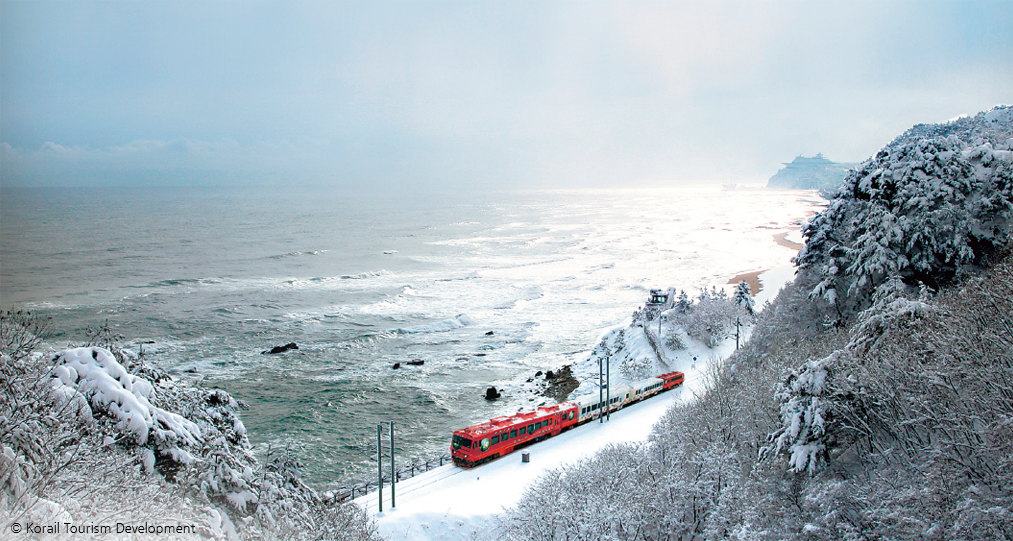
The Sea Train runs along the east coast.
The tourist train features tiered seats that allow passengers a clear view of the sea.
Romantic Winter Train Ride
Another way to enjoy the pristine winter landscape of this region is to hop on a train. Even the biting cold will seem romantic. Seated snugly in a comfortable seat, watching the snow fall outside the window will warm up your body and soul.
I once boarded the “Fantasy Snow Flower Train” that runs from December till February. Fellow travelers gathered on the platform, looking cheerful and excited for the brief respite from the everyday stress of driving to work on icy roads or commuting in a jam-packed subway car. It was a day trip starting from Seoul Station and stopping at Chujeon, Seungbu and Danyang, with scenic views of ravines filled with snow.
Just a short distance away from the city center, a striking snowscape unfolded before my eyes. The scenery of snow-capped roofs, and rice paddies and stream banks blanketed with snow warmed my heart. The train ran slowly, but still the wheels sprayed snow as it chugged along. Traveling with an acquaintance for the first time in a long while, eating gimbap and snacks together on the train, brought back old memories.
Our first stop was Chujeon Station in Taebaek. At 855 meters above sea level, it is the highest point in the country that can be reached by train. After eight minutes going through the 4.5 km-long Jeongam Tunnel, the station came into view. The name Chujeon means that the station was built where bush clovers grow. With low average annual temperatures, the place has exceptionally long winters. The train stopped at the station for around 20 minutes. I got off the train and stood on the platform. The cold air brushed across my cheeks.
The scenery of snow-capped roofs, and rice paddies and stream banks blanketed with snow warmed my heart. The train ran slowly, but still the wheels sprayed snow as it chugged along.
snowscape unfolded before my eyes. The scenery of snowcapped roofs, and rice paddies and stream banks blanketed with snow warmed my heart. The train ran slowly, but still the wheels sprayed snow as it chugged along. Traveling with an acquaintance for the first time in a long while, eating gimbap and snacks together on the train, brought back old memories.
Our first stop was Chujeon Station in Taebaek. At 855 meters above sea level, it is the highest point in the country that can be reached by train. After eight minutes going through the 4.5 km-long Jeongam Tunnel, the station came into view. The name Chujeon means that the station was built where bush clovers grow. With low average annual temperatures, the place has exceptionally long winters. The train stopped at the station for around 20 minutes. I got off the train and stood on the platform.
The cold air brushed across my cheeks.
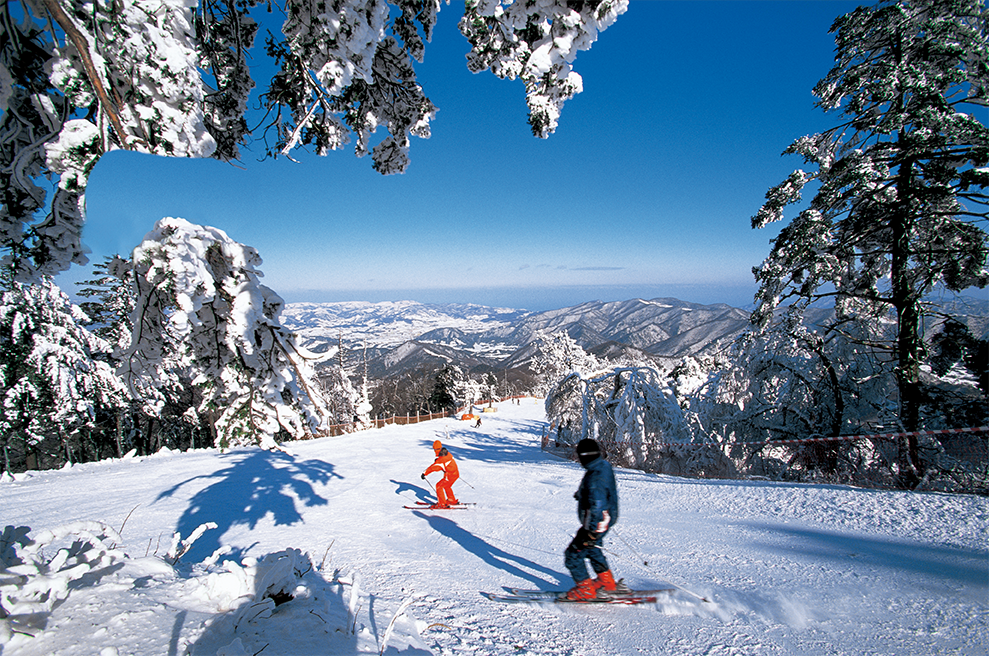
Yongpyeong Ski Resort in Pyeongchang, built in 1975, is Korea’s first ski resort and the mecca of winter leisure activities. As soon as the ski season starts in early winter, skiers and snowboarders flock here from across the country.
Specialty Coffee to Warm Your Winter
There’s nothing like a hot cup of coffee on a cold winter day. Gangneung, a seaside city in the province, has become a paradise for coffee lovers in recent years. It was hard to believe at first, but once I visited the city and saw it for myself, I understood why. Aside from the many coffee shops lining the streets, the city is home to a coffee museum, coffee farms and coffee roasters. It has also been hosting an annual coffee festival since 2009. There are currently around 200 coffee shops, whichan annual value added of over 200 billion won (approximately US$180 million).
The best place for drip coffee in Gangneung is Bohemian Roasters. The owner, Park I-chu, is a coffee master who played a crucial role in Gangneung’s transformation into the coffee mecca of Korea. A Korean-Japanese, Park is one of Korea’s four first-generation baristas. Two have passed away, and one emigrated to America, so he is the only one still active. He moved to Gangneung, opened a coffee shop and trained baristas; one could say that he pioneered the coffee boom in Gangneung.
Another place famous for its drip coffee is Terarosa, also called the “coffee factory.” It opened in 2002, the year of the Korea-Japan World Cup. They are serious about their coffee, and even go to Ethiopia and Guatemala to buy their beans.
Bong Bong Mill is another place coffee aficionados must visit in Gangneung. Located in Myeongju-dong, downtown Gangneung, it is a mill that has been converted into a café, hence the name. There is a separate space where customers can try their hand at making coffee and read coffee-related books. If these coffee shops have played a leading role in improving the quality of coffee in Gangneung, Coffee Cupper can be credited for spreading the coffee culture, being the first to commercially produce coffee in Korea.
Why not make the most of your winter by heading to Gangwon and enjoying the many winter wonders it has to offer, be it a mountain hike, romantic train ride, ice fishing, a winter festival, or just a hot cup of specialty coffee.
Gangneung Reborn as Coffee Mecca
Located in the middle of the east coast in Gangwon Province, Gangneung is the birthplace of many historic figures and famous for its ubiquitous cultural relics and sites. But in recent years, the city known for its antiquated charm has been enjoying newfound fame as Korea’s coffee mecca.
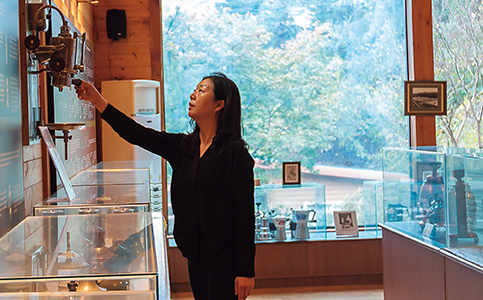
Choi Geum-jeong, director of the Coffee Museum in Wangsan-myeon, Gangneung, checks exhibits. Also the CEO of Coffee Cupper, she is devoted to promoting coffee culture.
It all began with coffee vending machines. They were first installed at Anmok Beach on the outskirts of Gangneung in the 1980s. Word gradually spread that the coffee here was particularly good, and people even visited the beach just to taste the coffee from these machines. Soon, there were dozens of vending machines. In 2001, a three-story coffee shop with glass walls opened here. The modern trendy coffee shop didn’t seem to belong in a fishing village with slate-roofed houses. The only coffee most people knew at that time was the cloyingly sweet type that was a mix of instant coffee, sugar and non-dairy creamer. The taste and aroma of freshly brewed coffee served at this coffee shop were unfamiliar. The price was also much higher than that of vending machine coffee.
Those who were used to drinking coffee in dark, oldfashioned coffee shops wondered who on earth would drink coffee at a place with glass walls where people can look inside, and expected it would close down soon. But they were proven wrong. In less than a year, people were lining up at the door.
More coffee shops started popping up, and in time, Anmok Beach, as well as the vicinity, was filled with a plethora of coffee shops. The “coffee street” became a magnet for tourists from all over the country.
were proven wrong. In less than a year, people were lining up at the door. More coffee shops started popping up, and in time, Anmok Beach, as well as the vicinity, was filled with a plethora of coffee shops. The “coffee street” became a magnet for tourists from all over the country.
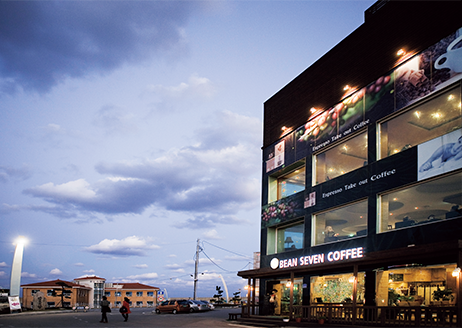
Choi Geum-jeong, director of the Coffee Museum in Wangsan-myeon, Gangneung, checks exhibits. Also the CEO of Coffee Cupper, she is devoted to promoting coffee culture.
It all began with coffee vending machines. They were first installed at Anmok Beach on the outskirts of Gangneung in the 1980s. Word gradually spread that the coffee here was particularly good, and people even visited the beach just to taste the coffee from these machines. Soon, there were dozens of vending machines. In 2001, a three-story coffee shop with glass walls opened here. The modern trendy coffee shop didn’t seem to belong in a fishing village with slate-roofed houses. The only coffee most people knew at that time was the cloyingly sweet type that was a mix of instant coffee, sugar and non-dairy creamer. The taste and aroma of freshly brewed coffee served at this coffee shop were unfamiliar. The price was also much higher than that of vending machine coffee.
Those who were used to drinking coffee in dark, oldfashioned coffee shops wondered who on earth would drink coffee at a place with glass walls where people can look inside, and expected it would close down soon. But they were proven wrong. In less than a year, people were lining up at the door.
Choi Byung-ilTravel and Leisure Reporter, The Korea Economic Daily
Shim Byung-wooPhotographer